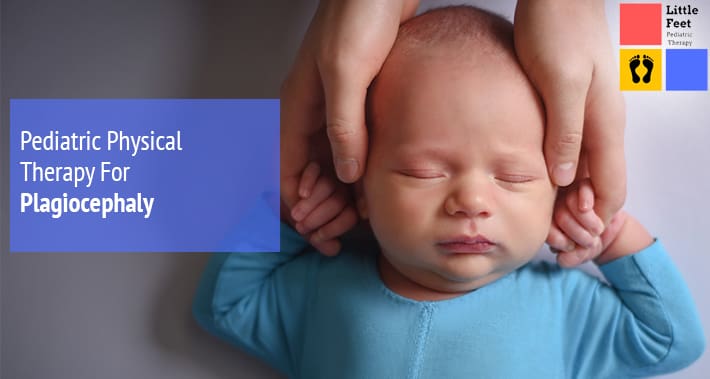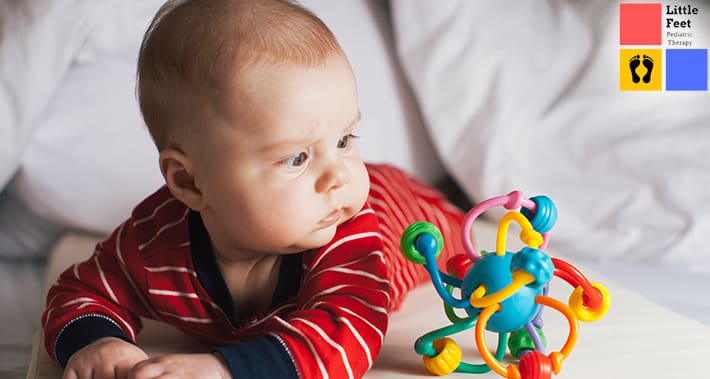
Plagiocephaly, otherwise known as flat head syndrome, is a common condition that can affect infants.
This condition causes your baby’s head to be flat on one side, typically due to their positioning as they grow.
While this can be the source of significant worry for parents, there are preventative measures that may help to avoid and correct plagiocephaly.
In the event your newborn does have this condition, a pediatric physical therapist can help.
Here at Little Feet, we’re a pediatric therapy clinic that offers pediatric physical therapy to help your child with plagiocephaly.
Keep on reading to learn more about plagiocephaly.
What Is Plagiocephaly?
Plagiocephaly refers to a malformation of the head.
There are several causes, but it results from your baby’s head being externally pushed on by a force, either before, during, or after birth.
As we’ve already mentioned, plagiocephaly is also known as infant flat head syndrome.
This is because typically part of your baby’s head will be flat on one side.
The extent of the condition can range from mild, to moderate, to severe.
If left neglected, the flat spot can become worse and lead to further physical issues on their head and face.
Brachycephaly and scaphocephaly are also conditions that can fall under the plagiocephaly classification.
With brachycephaly, your baby’s head will have a lower than normal length to width ratio with flattening seen symmetrically on the back of their head.
Scaphocephaly, on the other hand, involves a longer, narrower head shape where flattening is seen symmetrically on both lateral sides of the head, near the ears.
What Causes Plagiocephaly?
Let’s take a look at some potential causes of plagiocephaly.
There are a number of factors that can contribute to the development of this condition.
Consider that a newborn baby will spend a significant amount of their time on their backs.
If they typically lay in the same position on the same side, it can cause the area of contact on their heads to flatten over time.
This can increase the risk of them developing plagiocephaly.
This is one of the many reasons why tummy time is so important for developing babies.
Furthermore, certain baby toys and carriers can restrict your baby’s movement.
This includes certain baby swings, bouncy seats, DockATot sleepers, and others.
This can further increase their risk of developing plagiocephaly.
Infants with torticollis are also at greater risk for plagiocephaly.
This occurs when one side of their neck is tighter than the other.
This can also restrict their movements, making them favor one position, which can lead to plagiocephaly, and may also lead to issues with their vision and motor development.
RELATED: Pediatric Torticollis Therapy
Is Plagiocephaly A Sign Of Neglect?
The development of plagiocephaly in your infant isn’t a sign of neglect.
It’s caused by one of the factors mentioned above, none of which are related to neglect.
In fact, the most common cause of plagiocephaly is positioning while in utero.
It’s not your fault as a parent, nor does it represent any wrongdoing.
After birth, it typically happens because parents thought they were helping their baby, such as putting them on their backs in order for them to sleep.
Most parents understand that it’s best for your baby to sleep on their back.
This is an overall good idea, since it significantly reduces the occurrence of sudden infant death syndrome (SIDS).
However, it does increase the risk for plagiocephaly.
How To Tell If Your Baby Has Plagiocephaly
Let’s take a look at some signs and symptoms to watch out for to determine if your baby has plagiocephaly.
It’s a good idea to monitor your baby’s head shape by taking pictures from all angles and assessing them as they grow.
Plagiocephaly may not be always obvious unless it’s severe.
Look to see if their ears are aligned.
Misaligned ears or eyes along with different sized cheeks, and a more full forehead on one side, may be an indication of plagiocephaly.
Check to see if there is any flattening in the back or sides of your baby’s head as well.
When babies sleep on their backs with their head straight, it can cause the back of their head to flatten in the center.
Again, it’s a good idea to monitor and assess their head shape often and from multiple viewing angles to determine any changes or malformations.
While head shapes vary and have evolved, it’s important to look for any abnormal changes.
If left untreated, plagiocephaly can lead to more serious problems and conditions.
Speaking to a pediatric physical therapist can help you intervene early to prevent plagiocephaly.

How Can A Pediatric Physical Therapist Help With Plagiocephaly
A pediatric physical therapist can help assess the extent of your baby’s plagiocephaly and provide you with information.
By evaluating and taking measurements of your child’s head shape and face symmetry, their muscle mobility, and physical and sensory responses, they can create a treatment plan.
This involves giving tips for how to properly position your baby and encourage their mobility.
A pediatric physical therapist will work with you and your child to determine the underlying causes of their condition.
They can help implement strategies, such as proper positioning, more tummy time, and more, to alleviate pressure around the flat areas of their head.
They can also help you understand the range of motion of your baby’s neck and stretch out their tight muscles.
Additionally, a pediatric physical therapist can help find ways to develop your baby’s strength symmetrically.
Physical therapy can be beneficial for the prevention, treatment, and avoidance of worsening plagiocephaly.
Can You Prevent Plagiocephaly
While congenital plagiocephaly, which occurs in the womb, cannot be prevented, early intervention shortly after birth can help prevent the condition from worsening.
Plagiocephaly that occurs after birth can be prevented by correctly positioning your baby and keeping them mobile.
Positioning your baby to relieve pressure on their flat spot can help prevent it from getting worse.
Increased tummy time can further help alleviate some of that pressure and contact.
You can carry and hold them in a way that does not put pressure on their heads.
You can also limit the amount of time they spend in infant containers, such as car seats, bouncers, and more, which restrict their movement.
Additionally, it’s a good idea to change your baby’s position as often as you can to avoid them having a dominant position.
How Soon Should You Get Physical Therapy For Plagiocephaly
Early intervention is the best way to address your child’s plagiocephaly and to correct and prevent its progression.
If plagiocephaly is left untreated it can lead to further complications as they grow.
Early intervention with pediatric physical therapy can help prevent the condition from worsening and requiring your child to use a cranial band, or helmet.
A cranial band is a specialized helmet that’s specifically designed to control a baby’s natural head growth.
Plagiocephaly can improve without the need of a cranial band if you intervene early, especially before 5 months of age, and implement physical therapy strategies.
However, if your child does require a cranial band, the earlier they get one, the less time they will need to use it.
Even if your child is using a cranial band, pediatric physical therapy can still help address other issues they may have, such as muscle imbalance, mobility, and muscle strengthening.
Book Your Appointment With Little Feet Pediatric Therapy Today
If you notice your child’s head may be malformed and asymmetrical, it may be a sign of plagiocephaly.
If this is the case, don’t worry.
Speaking with a pediatric physical therapist can help answer your questions and assess their condition.
Here at Little Feet Pediatric Therapy, our physical therapists will work with you and your child to help prevent and offer treatment for their plagiocephaly.
Book your appointment with Little Feet Pediatric Therapy today.
► 3535 Randolph Rd, Charlotte, NC 28211
► 1331 H St NW Ste 200, Washington, DC 20005
► St. Louis, MO
► Raleigh, NC
Founded in 2019, Little Feet Therapy offers on site pediatric physical and occupational therapy treatments for children from 2 months to 18 years old with physical and developmental concerns. Our clinics focus on providing therapy in a child’s natural setting where your child is in familiar surroundings, it puts their mind at ease and helps them focus more on the work they’re doing with their pediatric therapist. Our therapists will work with your child at your home, at school, at daycare, or another place in the community where they feel most comfortable.